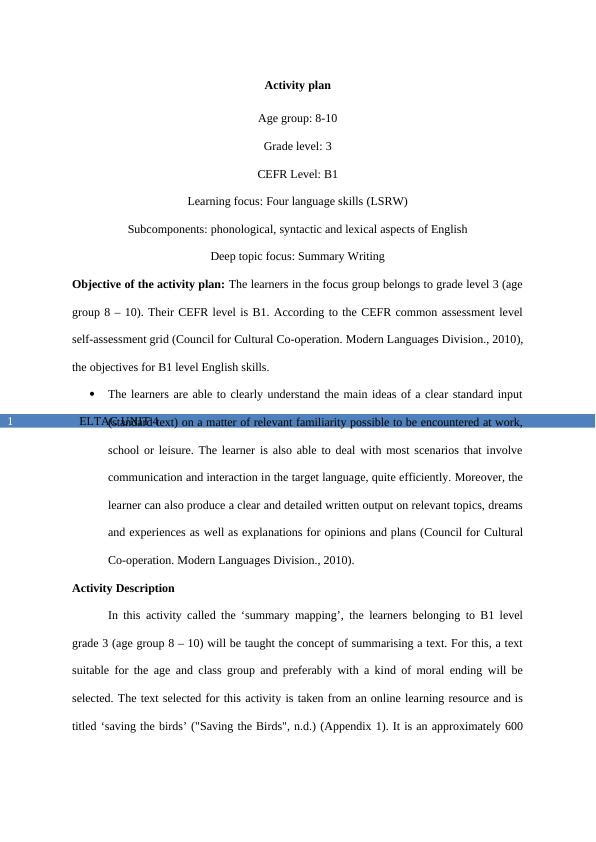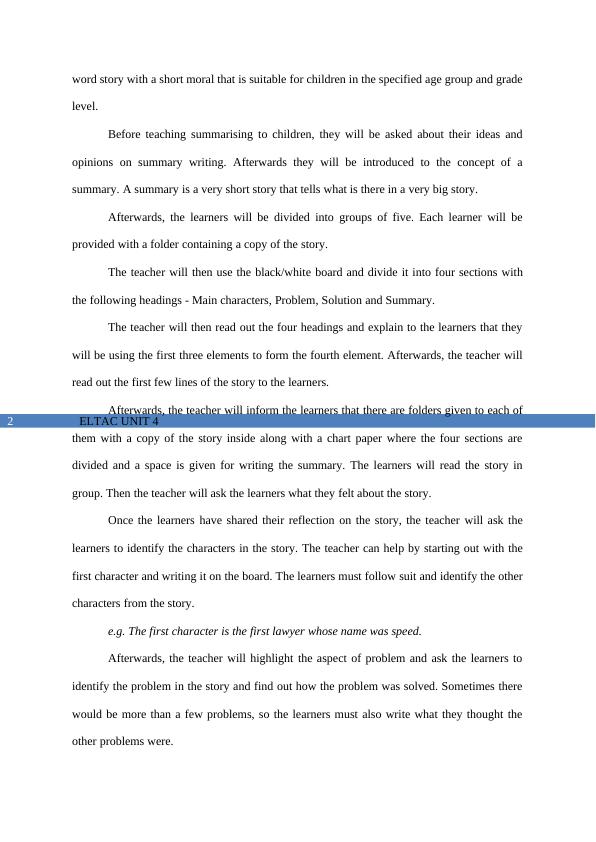ELTAC Unit 4: Summary Writing Activity Plan for Grade 3 Learners
Added on 2022-11-07
8 Pages2311 Words309 Views
Running head: ELTAC UNIT 4
ELTAC UNIT 4
Name of the Student
Name of the University
Author note
ELTAC UNIT 4
Name of the Student
Name of the University
Author note

ELTAC UNIT 41
Activity plan
Age group: 8-10
Grade level: 3
CEFR Level: B1
Learning focus: Four language skills (LSRW)
Subcomponents: phonological, syntactic and lexical aspects of English
Deep topic focus: Summary Writing
Objective of the activity plan: The learners in the focus group belongs to grade level 3 (age
group 8 – 10). Their CEFR level is B1. According to the CEFR common assessment level
self-assessment grid (Council for Cultural Co-operation. Modern Languages Division., 2010),
the objectives for B1 level English skills.
The learners are able to clearly understand the main ideas of a clear standard input
(standard text) on a matter of relevant familiarity possible to be encountered at work,
school or leisure. The learner is also able to deal with most scenarios that involve
communication and interaction in the target language, quite efficiently. Moreover, the
learner can also produce a clear and detailed written output on relevant topics, dreams
and experiences as well as explanations for opinions and plans (Council for Cultural
Co-operation. Modern Languages Division., 2010).
Activity Description
In this activity called the ‘summary mapping’, the learners belonging to B1 level
grade 3 (age group 8 – 10) will be taught the concept of summarising a text. For this, a text
suitable for the age and class group and preferably with a kind of moral ending will be
selected. The text selected for this activity is taken from an online learning resource and is
titled ‘saving the birds’ ("Saving the Birds", n.d.) (Appendix 1). It is an approximately 600
Activity plan
Age group: 8-10
Grade level: 3
CEFR Level: B1
Learning focus: Four language skills (LSRW)
Subcomponents: phonological, syntactic and lexical aspects of English
Deep topic focus: Summary Writing
Objective of the activity plan: The learners in the focus group belongs to grade level 3 (age
group 8 – 10). Their CEFR level is B1. According to the CEFR common assessment level
self-assessment grid (Council for Cultural Co-operation. Modern Languages Division., 2010),
the objectives for B1 level English skills.
The learners are able to clearly understand the main ideas of a clear standard input
(standard text) on a matter of relevant familiarity possible to be encountered at work,
school or leisure. The learner is also able to deal with most scenarios that involve
communication and interaction in the target language, quite efficiently. Moreover, the
learner can also produce a clear and detailed written output on relevant topics, dreams
and experiences as well as explanations for opinions and plans (Council for Cultural
Co-operation. Modern Languages Division., 2010).
Activity Description
In this activity called the ‘summary mapping’, the learners belonging to B1 level
grade 3 (age group 8 – 10) will be taught the concept of summarising a text. For this, a text
suitable for the age and class group and preferably with a kind of moral ending will be
selected. The text selected for this activity is taken from an online learning resource and is
titled ‘saving the birds’ ("Saving the Birds", n.d.) (Appendix 1). It is an approximately 600

ELTAC UNIT 42
word story with a short moral that is suitable for children in the specified age group and grade
level.
Before teaching summarising to children, they will be asked about their ideas and
opinions on summary writing. Afterwards they will be introduced to the concept of a
summary. A summary is a very short story that tells what is there in a very big story.
Afterwards, the learners will be divided into groups of five. Each learner will be
provided with a folder containing a copy of the story.
The teacher will then use the black/white board and divide it into four sections with
the following headings - Main characters, Problem, Solution and Summary.
The teacher will then read out the four headings and explain to the learners that they
will be using the first three elements to form the fourth element. Afterwards, the teacher will
read out the first few lines of the story to the learners.
Afterwards, the teacher will inform the learners that there are folders given to each of
them with a copy of the story inside along with a chart paper where the four sections are
divided and a space is given for writing the summary. The learners will read the story in
group. Then the teacher will ask the learners what they felt about the story.
Once the learners have shared their reflection on the story, the teacher will ask the
learners to identify the characters in the story. The teacher can help by starting out with the
first character and writing it on the board. The learners must follow suit and identify the other
characters from the story.
e.g. The first character is the first lawyer whose name was speed.
Afterwards, the teacher will highlight the aspect of problem and ask the learners to
identify the problem in the story and find out how the problem was solved. Sometimes there
would be more than a few problems, so the learners must also write what they thought the
other problems were.
word story with a short moral that is suitable for children in the specified age group and grade
level.
Before teaching summarising to children, they will be asked about their ideas and
opinions on summary writing. Afterwards they will be introduced to the concept of a
summary. A summary is a very short story that tells what is there in a very big story.
Afterwards, the learners will be divided into groups of five. Each learner will be
provided with a folder containing a copy of the story.
The teacher will then use the black/white board and divide it into four sections with
the following headings - Main characters, Problem, Solution and Summary.
The teacher will then read out the four headings and explain to the learners that they
will be using the first three elements to form the fourth element. Afterwards, the teacher will
read out the first few lines of the story to the learners.
Afterwards, the teacher will inform the learners that there are folders given to each of
them with a copy of the story inside along with a chart paper where the four sections are
divided and a space is given for writing the summary. The learners will read the story in
group. Then the teacher will ask the learners what they felt about the story.
Once the learners have shared their reflection on the story, the teacher will ask the
learners to identify the characters in the story. The teacher can help by starting out with the
first character and writing it on the board. The learners must follow suit and identify the other
characters from the story.
e.g. The first character is the first lawyer whose name was speed.
Afterwards, the teacher will highlight the aspect of problem and ask the learners to
identify the problem in the story and find out how the problem was solved. Sometimes there
would be more than a few problems, so the learners must also write what they thought the
other problems were.

End of preview
Want to access all the pages? Upload your documents or become a member.
Related Documents
ELTAC UNIT 3: Activity Plan for Speaking Skills Developmentlg...
|7
|1504
|395
Junior Level Lesson Plan | Environment and Pollutionlg...
|6
|917
|15
Compare Categories Transposition Beutifuallg...
|16
|4334
|26
English TEFL Lesson Planlg...
|8
|1213
|457
Assessing Prior Knowledge: Designing a Lesson on Language Learninglg...
|11
|2698
|176
Planning and Programming in TESOLlg...
|11
|2885
|26